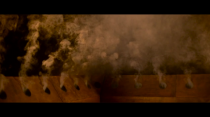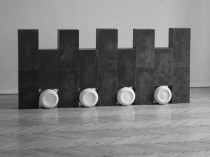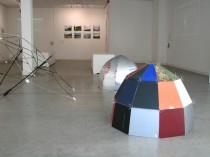Helen Shaddock is a Glasgow based artist whose work slides between painting and the three-dimensional. Her work stems from a curiosity with, and visual attraction to, colour, stripes, strata and natural & man-made patterns. She enjoys working directly with materials to explore form, colour and texture.
For 5 weeks during February and March 2013, Shaddock was artist in residence in Gallery 3 of Market Gallery, Duke Street, Glasgow. Helen used her blog as an online diary during the residency, tracking the development of her ideas and revealing the processes used to make the work. Here, Shaddock tells us about her residency and the resulting exhibition.
Several times a year, Market Gallery invites artists to apply to participate in its ‘Studio Projects’. This programme includes a four-week residency in one of Market’s gallery spaces and a resulting four week exhibition.
My proposal for the Studio Project was to conduct intensive research into colour and test the possibilities of combining controlled processes with chance elements when making work. I wanted to respond to the industrial nature of the gallery and make the most of the space, enabling me to work on a larger scale and experiment with the installation of work.
I specifically wanted to extend my work using plaster, polymer and pigments. I had previously used drainpipes as moulds to create column-like sculptures, but was keen to make my own moulds. The casting process is labour intensive and time consuming, but I was lucky enough to benefit from having a team of Market Gallery volunteers who kindly assisted me in the production of the work. This was a huge help, as someone could hold the mould while the other person poured the plaster. It also allowed me to work on a scale that I have never been able to achieve on my own. Some of the sculptures became so large that it took a team of four people to remove the cast from the mould!
I began by making funnel moulds from lino and dripping layers of different coloured plaster inside. I then poured more layers of different coloured plaster into the mould and rotated the funnel until the plaster covered the inside of the mould and set as a hollow sculpture. I repeated this numerous times until it was strong enough to remove from the mould.
I also made casts whereby I applied layers of different coloured plaster and then fully filled the lino moulds, leaving them to rest at an angle so as to create a less predictable shape.
I embraced the unexpected and allowed for chance elements within the process. Removing moulds from casts is exciting and can be quite nerve-wracking, particularly when I have invested a lot of time and resources into creating something that I do not know will work. When I took one of the sculptures out of its mould, I noticed that the pattern left on the lino was very interesting. In fact, I felt that this was more curious than the sculpture.
I am interested in the relationship between two-dimensions and three-dimensions and wanted to create a sheet of plaster that would be able to stand or be propped against a wall. I covered sheets of cardboard in parcel tape and then used a variety of techniques to coat the surface with layers of coloured plaster.
Conscious of the amount of floor based work that I was producing, I developed some wall-based works so as to make for a more interesting viewing experience. Referring back to the gallery space, I made a number of ‘object paintings’ the shape and size of the breezeblock walls.
I continued to use cardboard and parcel tape to make angular moulds, creating some unusual forms.
I had prepared some solid birch triangular shapes with plywood edges that could fit together and support each other. I played with the surface of the wood, leaving some faces bare so as to acknowledge the beauty of the wooden grain. I also poured different coloured plaster onto the surface that had a plywood boundary, and adopted an experimental screenprinting method using stencils on the reverse side. I assembled the pieces so that there would be surprise elements for the viewer when they walked around the form.
Over the duration of the residency I had produced a vast amount of work, and selecting what to include in the exhibition was a challenge. I wanted the installation of the exhibition to reveal signs of the production of the work, and did not want to present each piece as an autonomous object.
Overall the residency was an amazing experience and allowed me to produce work to a scale that I could not achieve in my studio. The public seemed to enjoy watching the development of the work as they passed the gallery each day, and I had some great chats with passersby who were intrigued by what I was doing. I am delighted with the work, and feel that there is real potential for further development.
I would like to thank the wonderful team of Market Gallery volunteers who assisted in the production of the work, the other artists exhibiting at Market Gallery, and the Market Gallery committee for their support and for helping make the residency such a positive experience.
The exhibition runs until 12 April and the gallery is open 11am – 5pm Thursday – Sunday.
This project is supported by Creative Scotland who awarded Helen Shaddock with Talent and Professional Development funding.
Where to find out more:
Website | Blog | Facebook
//////
Want to read more blogs by artists? Look here.





























Comments